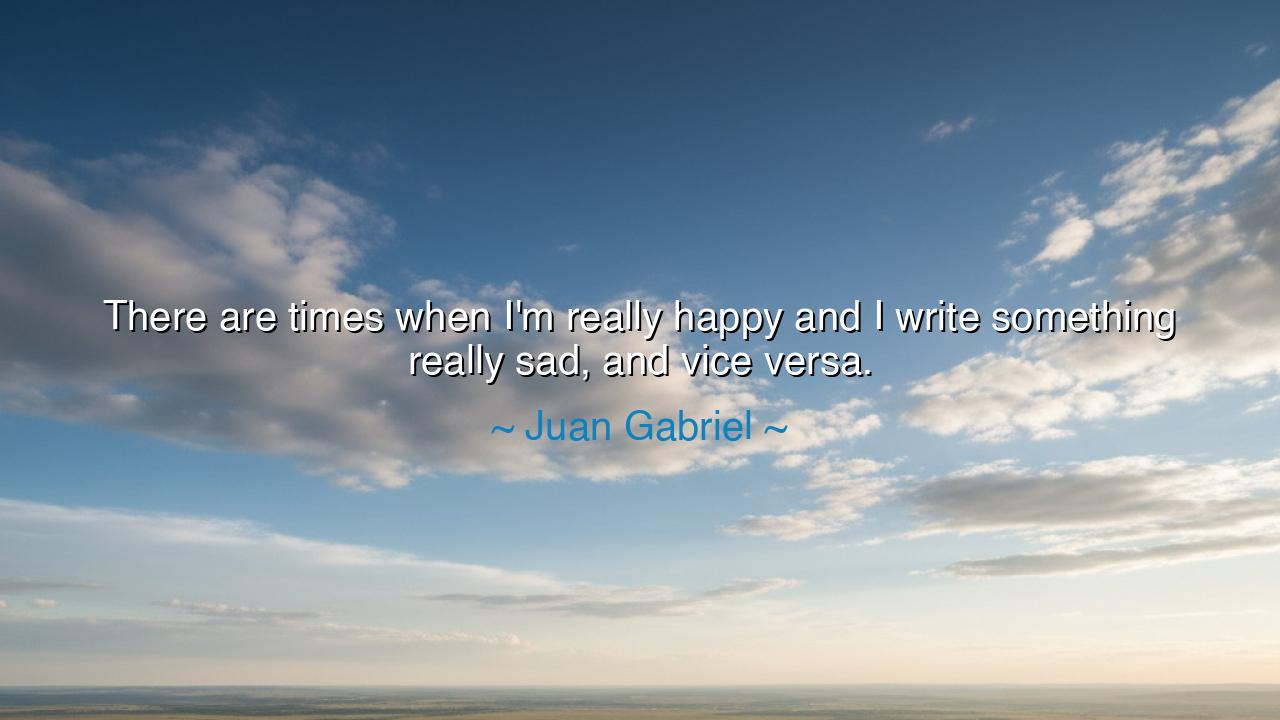
There are times when I'm really happy and I write something
There are times when I'm really happy and I write something really sad, and vice versa.






There is a profound and paradoxical wisdom in the words of Juan Gabriel, who said, “There are times when I’m really happy and I write something really sad, and vice versa.” In this reflection lies the eternal duality of the human heart — that joy and sorrow are not opposites, but reflections of one another. The great artist understood that emotion is not a simple river that flows one way, but a vast ocean where waves of laughter and tears meet, crash, and blend into something more beautiful and true. His words remind us that art, like life, is born from contradiction — and that even in happiness, the soul may remember its pain.
The origin of this quote comes from the life of a man who knew both poverty and glory, exile and adoration. Juan Gabriel, one of the most beloved singers and songwriters in Latin America, was a master of emotional truth. Orphaned at a young age and shaped by hardship, he learned early that joy must often be built from sorrow. Yet when success came, he did not abandon the melancholy that once sustained him. In his songs, laughter danced beside heartbreak; celebration stood beside grief. His words reveal an artist who understood that creation does not always mirror mood — that sometimes the heart sings most honestly when it sings in contrast.
This paradox has existed since the dawn of creation. The ancients knew that light and darkness are not enemies, but companions. The Chinese spoke of yin and yang — the eternal balance of opposites that together form harmony. The poet Homer sang of Achilles, whose greatest triumph brought both glory and grief. So too did Leonardo da Vinci paint both the serenity of the Mona Lisa and the storm of The Last Supper, proving that the same hand can hold both calm and chaos. Juan Gabriel’s insight belongs to this same lineage of understanding: that emotion is not one color, but a spectrum, and that truth often emerges from the meeting of contradictions.
When he says he wrote “something really sad” while happy, we see not confusion, but awareness. Happiness does not erase sorrow; it gives us the safety to face it. Likewise, when sadness leads him to write something joyful, it is because the human spirit, even in despair, yearns for light. This is the rhythm of the creative soul — to transform one feeling into another, to weave darkness into melody and let pain become beauty. The artist becomes like a gardener of emotion, planting seeds of joy in sorrow’s soil and watching something radiant grow.
Consider the story of Frédéric Chopin, who, though frail and ill, composed music of exquisite grace and vitality. His body suffered, but his soul danced. The sweet sadness in his nocturnes and the quiet triumph in his waltzes reveal the same truth that Juan Gabriel speaks of: that joy and sorrow are never separate — they are two hands of the same spirit, shaping the sculpture of a life well-lived. The greatest art, and the deepest wisdom, come not from one emotion alone, but from the meeting of both.
In truth, the human heart cannot live in only one season. Just as day gives way to night and winter melts into spring, our emotions flow from one to the other. To deny sadness while happy, or to suppress joy while mourning, is to live only half a life. The wise — like Juan Gabriel — learn to let both coexist. They understand that the power of creation lies in embracing the fullness of experience. When the artist writes a sad song while happy, he honors the memory of his pain; when he writes a joyful one in sorrow, he calls forth the strength to endure.
The lesson, then, is not merely artistic but spiritual: embrace your contradictions. Do not fear the complexity of your feelings, for they are the tapestry of your humanity. If you are happy and feel sorrow stirring within, let it speak. If you are broken yet long to laugh, let it rise. Life is not meant to be tidy or linear — it is meant to be felt in its fullness. To live deeply is to accept that joy and pain will forever dance together, each giving meaning to the other.
So remember, as Juan Gabriel did, that the heart is vast enough to hold both light and shadow. When you create, love, or simply live, let every emotion find its voice. For it is in the blending of opposites that we find harmony, and in the harmony of all feeling that we find truth. The song that is born from both tears and laughter — that, my children, is the song that lives forever.






AAdministratorAdministrator
Welcome, honored guests. Please leave a comment, we will respond soon